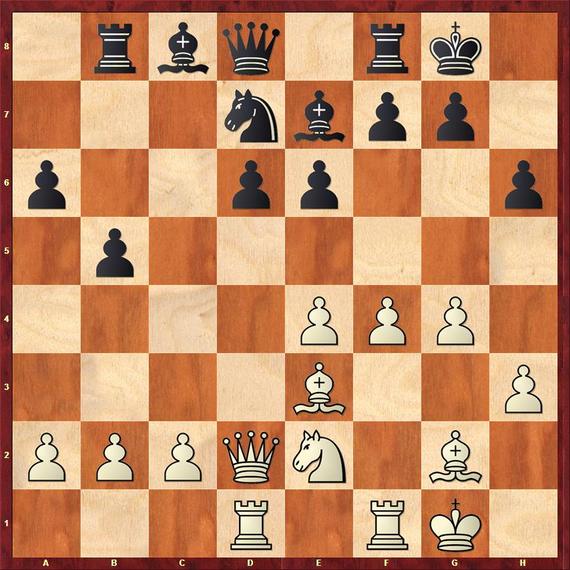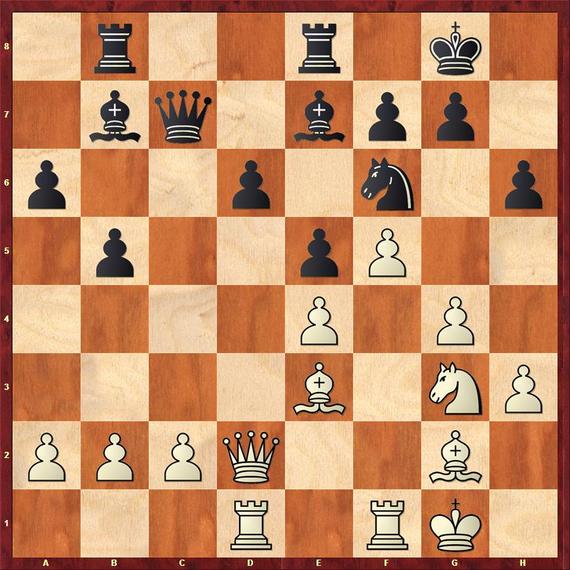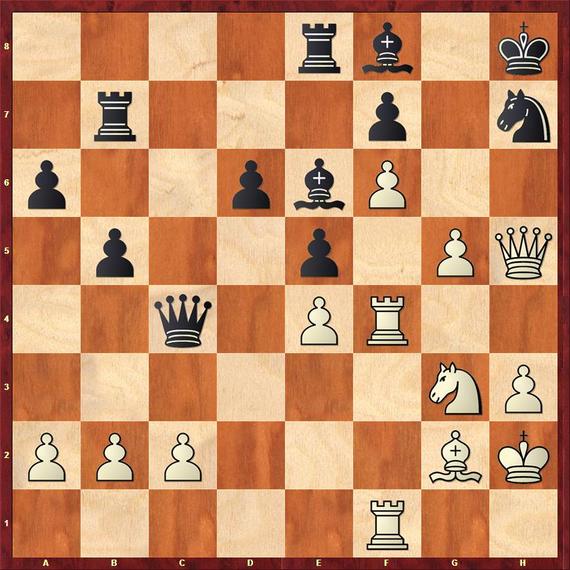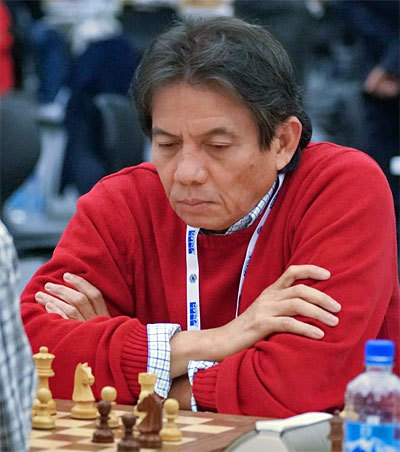Chess shifted to Asia this week: for the first time two Asian teams
stepped on the podium to claim olympic medals.
The young Chinese team won the 41st Chess Olympiad in Tromsø, Norway. They became the only undefeated team among 176 participating countries, winning eight matches and tying three, scoring 19 points. The Hungarians won the silver medals on a tiebreak over India, both scoring 17 points. Azerbaijan and the top rated team of Russia also scored 17 points, but their tiebreaks were not good enough.
Russia won the Women's Olympiad with 20 match points and China edged Ukraine on a tiebreak after both scored 18 points.
The average age of the winning Chinese team was 21. The 20-year old Yu Yangyi, had the best olympiad rating performance of 2912, scoring 9.5/11. India sneaked into the third place without having the top two rated players, former world champion Vishy Anand and Pentala Harikrishna, on the team. They were led by Parimarjan Negi, 21, on the first board.
Hungary's second place was overshadowed by Judit Polgar's announcement that she is retiring from professional chess. The all-time best woman concluded her illustrious chess career in Tromsø as the reserve player on the silver medal team.
The world champion Magnus Carlsen lost two games as the home team of Norway finished 29th. The former world champion Vladimir Kramnik also dropped two games and for the third time in this century the men's team of Russia did not win any medals (the other two times were in Turin in 2006 and in Dresden in 2008).
Five rounds before the end Russia was soundly defeated by the Czech team 3:1. They tied with Spain next and their finishing spurt came too late. We present a dramatic duel on the first board from the match Czech Republic - Russia. David Navara's bishop sacrifice against the time-pressure addict Alexander Grischuk was well-timed.
Navara,David - Grischuk,Alexander
41st Olympiad, Tromsø 2014
1.Nf3 c5 2.e4 d6 3.d4 cxd4 4.Nxd4 Nf6 5.Nc3 a6 6.h3 e6
Breaking into the Scheveningen Sicilian is the most popular choice.
7.g4 h6 8.Bg2 Be7 9.Be3 Nc6 10.f4 Nd7 11.0-0
Avoiding Be7-h4+.
11...Nxd4 12.Qxd4 0-0 13.Qd2
The queen retreats to avoid pawn punches in the center. It also creates a battery with the bishop, aiming at a potential target: the pawn on h6.
In this position, Alexei Shirov chose to switch the knight to h5 via e2 and g3: 13.Ne2 b5 14.Ng3 Bb7 15.Nh5 e5 16.Qd2 Nf6 but after confronting the active knight, black equalized in Shirov-Sutovsky, Poikovsky 2014. The game was drawn in 44 moves.
13...Rb8 14.Rad1 b5 15.Ne2
The last piece that can be attacked retreats voluntarily, reinforcing the kingside attack and leaving black without a target on the queenside.
15...Qc7 16.f5
Opening the diagonal c1-h6.
16...Nf6
Grischuk wants to have the possibility to break in the center with d6-d5. Otherwise he would have chosen 16...Ne5, for example 17.b3 and now:
A. 17...Kh7 18.Nf4 Rd8 19.Nh5 Bh4 20.g5 hxg5 21.Bxg5 Bxg5 22.Qxg5 f6 23.Qh4 (The piece sacrifice does not win: 23.Nxf6+?! gxf6 24.Qxf6 Rb7 25.Rf4 Qb6+ 26.Kh1 Rg7 27.Rg1 Kg8 28.fxe6 Re8 29.e7 Rf7 30.Qg5+ Rg7 31.Qf6=) 23...Kg8 24.Kh2 Rf8 (24...Qxc2 25.Qg3+-) 25.Rf2 with white's edge.
B. 17...Rd8 runs into a strong exchange sacrifice: 18.f6! Bxf6 19.Rxf6! gxf6 20.Nf4 and the black king is vulnerable through dark-square weaknesses. White's attack flourishes, for example: 20...Kf8 21.Nh5 Ke7 22.Qf2 Nd7 23.Nxf6! Nxf6 24.Rf1.
17.Ng3
Navara covers his pawn on e4 and Grischuk, with only about seven minutes left on his clock, is without an obvious target. The disadvantage is that white can't pressure the pawn on e6 and black can play 17...Bb7.
17...Re8
Opening the square of f8 for the bishop and enticing white to sacrifice something. For example, 17...Bb7 18.Bxh6!? gxh6 19.Qxh6 d5 an now:
A. 20.Rd3 dxe4 21.Rc3 Qe5 22.Qg5+ Kh8 23.Qh4+ is equal.
B. 20.Kh2 20...Bd6 21.Qg5+ leads to a perpetual check.
18.Bd4
Navara played the provoking move after a long deliberation. An exchange sacrifice on f6 is in the air. He might have been considering 18.fxe6 producing a dilemma for black:
A. 18...Bxe6!? the correct capture 19.Nf5 Bxf5 20.Rxf5 and now 20...Rbc8!? 21.Bxh6 Bf8! dwarfs the attack. But after 20...Nd7 21.e5!? Nxe5 22.Bd5 Bf6 23.Bxh6 Nc4 24.Qf2 white may claim a tiny advantage.
B. 18...fxe6?! is weaker because of 19.Bxh6! gxh6 20.Qxh6 and white has a winning attack. 20...Bd8 (20...Nh7 21.Qg6+ Kh8 22.Rf7+-) 21.e5! dxe5 22.Nh5 Rb7 (22...Nxh5 23.Qg6+ Ng7 24.Be4+-) 23.Rxd8! wins.
After the immediate sacrifice 18.Bxh6 gxh6 19.Qxh6 black succeeds to cover the dark squares with 19...Nh7 20.Nh5 Bf8 with the edge.
18...e5
White's last move was not just a teaser, forcing to close the center, it threatens to crack open the doors to the black king via the square f6, for example 18...b4 19.fxe6 Bxe6 20.Bxf6 Bxf6 21.Rxf6 gxf6 22.Nh5 Qc5+ 23.Kh1 Qg5 24.Qd4 with a strong pressure.
But the exchange sacrifice is less effective after 18...Bb7 19.fxe6 fxe6 20.Rxf6 Bxf6!? (20...gxf6?! 21.Qxh6 Bf8 22.Qxf6 Bg7 23.Qg6 Qf7 24.Qxf7+ Kxf7 25.Rf1+ Kg8 26.Bxg7 Kxg7 27.Nh5+ Kh8 28.Rf6±) 21.Bxf6 gxf6 22.Nh5 Rf8 23.Rf1 and black defends with 23...Qc5+ 24.Kh1 Qg5 25.Qxd6 Rbe8 26.Qd7 Bc8 equalizing.
19.Be3 Bb7
Black could have kept his bishop on the diagonal c8-h3 and moved the rook from the square e8 where it would become exposed later: 19...Rd8 20.Bxh6 gxh6 21.Qxh6 Nh7 22.f6 Bf8 23.Qh5 Kh8 24.g5 Be6 with a playable game.
20.Bxh6!
A dangerous sacrifice in opponent's time trouble.
20...gxh6
Accepting the sacrifice has been criticized in favor of the cold-blooded 20...d5 and black seems to be fine, for example:
A) 21.exd5 gxh6 22.Qxh6 e4! 23.Qg5+ (23.d6 Qb6+ 24.Kh1 Nh7 25.Qh5 Bxd6 26.g5 e3 27.g6 Bxg2+ 28.Kxg2 Qb7+ 29.Kg1 fxg6 30.Qxg6+ Kh8 31.Qxd6 e2 32.Qd4+ Kg8 33.Qg4+ Kh8 34.Qd4+=) 23...Kh8 24.Qh4+ Nh7 25.f6 Qb6+ 26.Kh1 Bxf6 27.Qh5 e3 28.Rde1 Re5 and black beats the attack.;
B) 21.Bxg7 Kxg7 22.g5 Bc5+ 23.Kh2 Nxe4 24.Bxe4 dxe4 25.f6+ Kg6 26.Qe2 Rh8 27.Qg4 Qc8 28.Rd7 Qxd7 29.Qxd7 Bc8 30.Qc7 Bxh3=
C) 21.Bg5 dxe4 22.Kh2 (22.Bxf6 Qb6+ 23.Kh2 e3 24.Qe2 Bxf6 25.Bxb7 Rxb7 26.Ne4) 22...Red8 23.Qe2 Nd5=
21.Qxh6 Nh7
Instead of this natural move, black could have tried a clever defense 21...d5 22.g5 Bf8!? (But not 22...Nxe4? 23.Bxe4 Bf8 24.Qh4 dxe4 25.Nh5 and the attack succeeds) and only after 23.Qh4! (23.Qxf6?? Bg7 catches the queen.) 23...Nh7. White can still break through:
A. 24.f6! the only way 24...Kh8 25.exd5 e4 26.Bxe4 Rxe4 27.Nxe4 with advantage.
B. 24.exd5?! f6 (24...Qxc2 25.Be4 Qc5+ 26.Kh2+-) 25.gxf6 Qb6+ 26.Kh2 Qxf6 27.Qg4+ Kh8 and black survives.
22.f6 Bf8
After 22...Bxf6 23.Rxf6 Nxf6 24.Nf5 wins.
23.Qh5 Qc5+
Grischuk sees he can exchange the queens, but it would not help him. Instead, the computers suggest 23...Kh8 although after 24.g5 black has no counterplay and white can quietly improve his attack. One idea is to bring the light bishop from g2 to f5; another is to bring the rook on h4, for example: 24...Bc8 25.Rf2 Rb7 (25...Qc4 26.Nf5 Bxf5 27.exf5+-) 26.Rdf1 Be6 27.Kh2 Qc4 28.Rf4!! and white wins.
It would be a time pressure horror.
24.Kh2 Qe3 25.h4 Qh6 26.Qxh6 Bxh6
The pawn avalanche is rolling.
27.g5 Bf8
Other moves do not help either:
A. 27...Nxg5 28.Nf5;
B. 27...Bxg5 28.hxg5 Nxg5 29.Nf5 (29.Rf5) 29...Re6 30.Ng7 Rxf6 31.Rxf6 Kxg7 32.Rfxd6 Rh8+ 33.Kg3 Nxe4+ 34.Bxe4 Bxe4 35.Rxa6 Bxc2 36.Rd5 and white should win.
28.g6!
A tactical solution: white wins back a piece.
28...Bh6
28...fxg6 29.f7++-;
28...Nxf6 29.Rxf6 fxg6 30.Rxg6+ Kh7 31.h5 black suffers on the light squares.
29.Nf5!
A decisive leap. Grischuk's game collapses like a house of cards.
29...Bf4+
It doesn't matter what black plays. After 29...Bf8 30.g7 wins.
30.Rxf4! Nxf6
After 30...exf4 31.Nh6+ Kf8 32.g7 mates.
31.gxf7+ Kxf7 32.Nxd6+ Ke7
White also wins after 32...Kg6 33.h5+ Nxh5 34.Rg4+ Kf6 35.Nxe8+ Rxe8 36.Rd6+ Ke7 37.Rh6 Nf6 38.Rg7+ Kf8 39.Rgg6 Ng8 40.Rh7+-
33.Nxe8
This is a simple way to victory. The analytical engines beg for 33.Rf5 Red8 34.Rxe5+ Kf8 35.Bh3+-.
33...exf4 34.Nxf6 Kxf6 35.Rd6+ Ke5 36.Rb6!
A devastating pin. Black does not have any good moves.
36...f3 37.Bxf3 Rf8 38.Kg3 Bxe4 39.Bxe4 Kxe4 40.Re6+ Black resigned.
The U.S. team finished just one match point out of the podium in 14th place, but the future looks bright. Sam Shankland pulled no punches with 9 points out of 10 games. He reminds me of the young Jim Tarjan, who used to amass high scores for the U.S. team in the 1970s. Next Olympiad may include Wesley So, a young Philippine GM with Bobby Fischer's touch, rated among the world's top 12 players.
The first Asian grandmaster Eugene Torre, 62, broke the all-time record: he participated in 21 Chess Olympiads. The former FIDE world champion Veselin Topalov of Bulgaria had the best result on the first board. Nearly 6730 games were played in Tromsø.
Kirsan Ilyumzhinov was re-elected FIDE president. He gained 110 votes; his opponent, the former world champion Garry Kasparov, had 61 votes.
Note that in the replay windows below you can click either on the arrows under the diagram or on the notation to follow the game.
Images Paul Truong, Ray Morris-Hill and Ladislav Palovský

